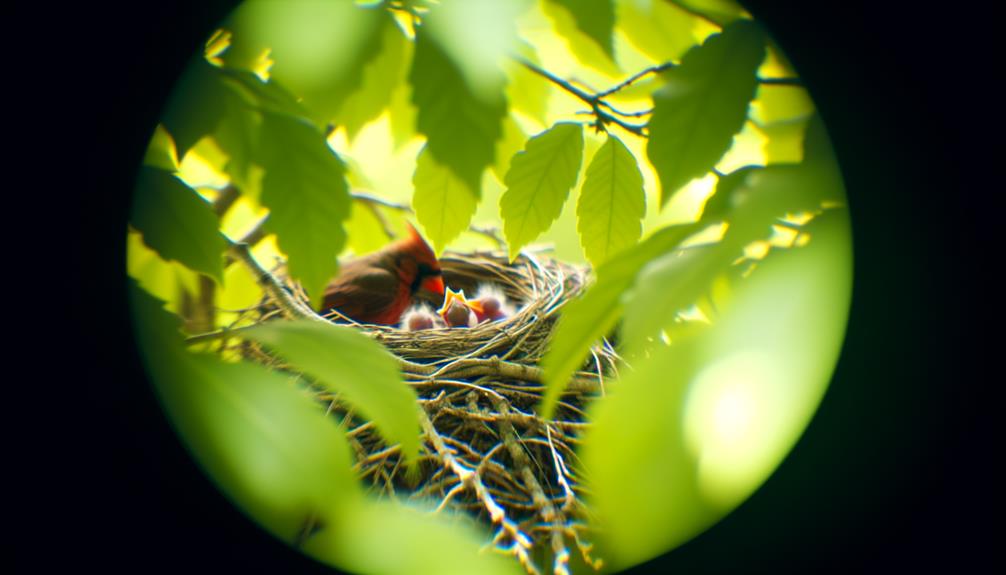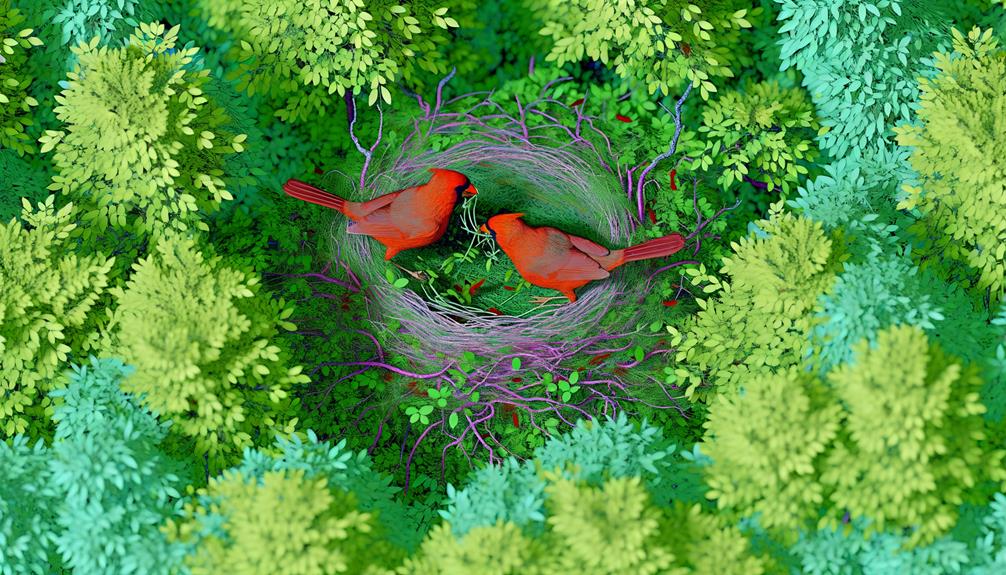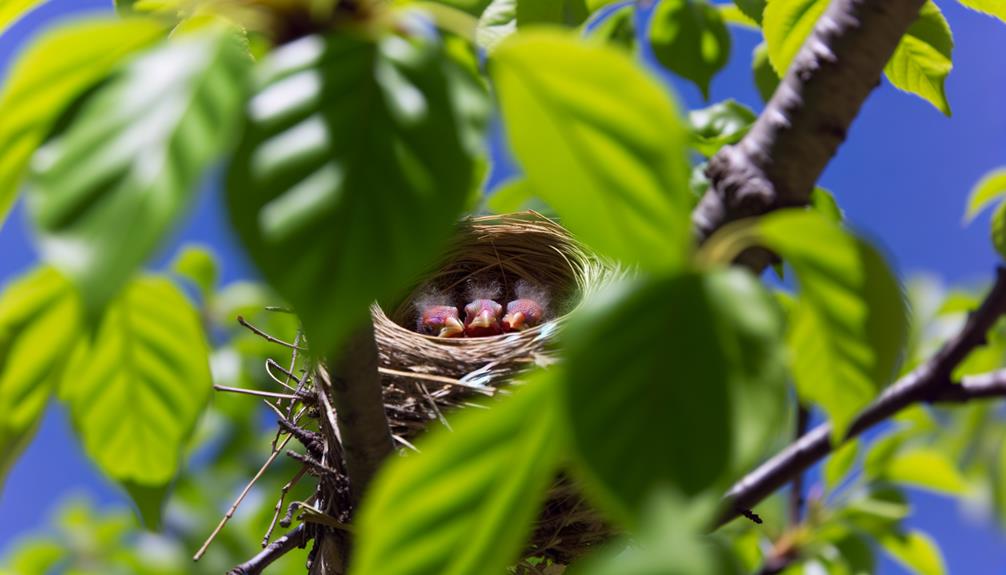How Long Do Cardinals Stay in the Nest?
Cardinal nestlings stay in the nest for about 9 to 11 days after hatching. During this time, they undergo rapid growth, forming feathers and preparing for flight.
Both parents play active roles; the female incubates the eggs for 11 to 13 days, while the male provides food. Once hatched, nestlings are closely monitored and fed by their parents.
Observing these stages reveals fascinating details of their development, from fragile hatchlings to ready fledglings. The post-hatching period is pivotal for their survival, with each stage offering keen insights into their life cycles.
There's so much more to discover about their journey.

Key Takeaways
- Cardinal nestlings typically remain in the nest for 9 to 11 days after hatching.
- Both parents feed and protect the nestlings during their time in the nest.
- Rapid growth and feather development occur while nestlings are in the nest.
- Nestlings leaving the nest are called fledglings and begin to explore their surroundings.
- Parental care continues after fledging, aiding in the young birds' survival.
Nest Building Process

During the nest building process, you'll observe cardinals meticulously selecting twigs, leaves, and grasses to create a sturdy foundation. They prefer dense shrubs or low tree branches, ensuring a hidden, secure spot.
The female takes the lead, shaping and weaving the materials with precision. You'll notice how she uses her beak to intertwine various elements, crafting a cup-like structure. The male assists by gathering supplies, showcasing a true partnership.
This intricate construction typically takes 3 to 9 days, depending on environmental conditions and material availability. Every detail matters; the nest must protect against predators and withstand weather fluctuations.
Egg Laying Period
You'll observe that the egg-laying period in cardinals begins with careful nesting site selection.
The female then lays eggs, which she incubates for about 11 to 13 days, ensuring ideal temperature and protection.
During this time, both parents share responsibilities, with the male often providing food and guarding the nest.
Nesting Site Selection
As spring arrives, female cardinals carefully choose nesting sites that offer both concealment and proximity to food sources to ensure the safety and nutrition of their future offspring.
You'll notice they often select dense shrubs or thickets, ensuring the nest remains hidden from predators. They prefer locations near abundant food supplies, such as berry bushes or feeders, to minimize the energy expended on foraging.
The female constructs the nest using twigs, leaves, and grasses, forming a sturdy cup shape. This meticulous selection and construction process is vital for the survival of the eggs and eventual hatchlings.
Incubation Duration
Once the female cardinal has completed the nest, she lays between three to four eggs, which she incubates for approximately 11 to 13 days. During this period, you'll observe her staying close to the nest, maintaining a consistent temperature necessary for embryo development.
She'll carefully regulate heat by adjusting her position, ensuring each egg receives the best warmth. Remarkably, her instinct drives her to turn the eggs several times a day, promoting even growth. This diligent behavior is vital, as it prevents the embryos from sticking to the shell.
While the male cardinal often brings food, the female remains steadfast, seldom leaving the nest. This precise incubation process is needed for the successful hatching of healthy cardinal chicks.
Parental Care Responsibilities
During the egg-laying period, both male and female cardinals exhibit a well-coordinated effort to guarantee the safety and nourishment of the developing embryos.
You'll notice the female staying close to the nest, carefully laying one egg per day. She meticulously arranges her body to provide ideal warmth.
The male, on the other hand, takes on the role of the provider. He's constantly foraging for food, bringing back seeds and insects to optimize the female's nourishment.
This division of labor is essential; the female's uninterrupted presence deters predators, while the male's foraging keeps both parents strong.
Their synchronized actions highlight a remarkable natural partnership, ensuring the best possible start for their future offspring.
Incubation Duration

Typically, a cardinal's incubation period lasts about 11 to 13 days, during which the female diligently keeps the eggs warm and protected. You'll notice her rarely leaving the nest, as she relies on the male to bring food. Her constant presence guarantees the eggs maintain a stable temperature, vital for proper development.
The nest itself, usually hidden in dense shrubbery, provides additional insulation and security from predators. You might observe her occasionally turning the eggs, a behavior that promotes even warming and prevents the embryos from sticking to the shell.
This period is an intricate dance of patience and care, reflecting the cardinal's instinctive drive to secure the survival of her offspring.
Hatching Phase
In the hatching phase, you'll observe that cardinal eggs typically incubate for about 11 to 13 days before they start to hatch.
Once the eggs crack open, the nestlings begin their development stages, which include rapid growth and feather formation.
It's important to monitor these stages closely to understand how quickly they progress from helpless chicks to fledglings ready to leave the nest.
Egg Incubation Period
The cardinal's egg incubation period lasts approximately 12-13 days, during which the female remains dedicated in maintaining the best temperature for embryo development. You'll observe her carefully adjusting her position to secure uniform warmth.
She rarely leaves the nest, relying on the male to bring food. This period is essential, as consistent warmth is crucial for the successful hatching of the chicks. The female uses her brood patch—a bare, featherless area on her belly—to transfer heat directly to the eggs.
Humidity also plays a role; she occasionally shifts the eggs to maintain ideal moisture levels. During this phase, the developing embryos gradually form, preparing for their emergence into the world. Your keen observation reveals nature's intricate balancing act.
Nestling Development Stages
As hatching begins, you'll notice the tiny chicks breaking free from their shells, often within a span of just a few hours. The process starts with pipping, where the chick uses its egg tooth to crack the shell. Observing this, you'll see a determined struggle, as they twist and push to emerge.
Once out, the nestlings appear wet and vulnerable, their skin almost translucent. They rely heavily on their parents for warmth and food at this stage. Their eyes remain closed, and they're mostly immobile, conserving energy.
Despite their fragile appearance, these chicks are resilient, beginning their journey of rapid growth. Within days, they'll gain strength, their down feathers drying and fluffing up, preparing for the next stage of development.
Nestling Development

During the nestling development phase, you'll observe that cardinal chicks undergo rapid growth and physiological changes essential for their survival. Their eyes open within 3-4 days, allowing them to start responding to their environment.
Down feathers give way to juvenile plumage, providing better insulation and aiding in temperature regulation. You'll notice that their begging calls become louder and more persistent, indicating a robust feeding response.
Parents tirelessly feed the nestlings a diet rich in insects, vital for their protein needs. Muscle development, particularly in wings and legs, becomes evident as they start exercising by flapping and stretching.
This phase is pivotal, as it prepares them for the challenges of fledging and independent life.
Fledging Time
Around 10-12 days after hatching, you'll notice cardinal chicks start making their first attempts to leave the nest, a critical period known as fledging time. During this phase, they rely on their rapidly developing wing muscles to explore their surroundings. Observing this transformative stage can be enchanting.
Key markers of fledging time include:
- Wing Flapping: Chicks frequently practice flapping their wings.
- Perching Attempts: They try to balance on nearby branches.
- Parental Guidance: Adult cardinals stay close, offering food and protection.
- Gradual Independence: Each day sees the fledglings gaining more confidence and distance from the nest.
This period is essential for the young birds' survival, as it prepares them for the independence and freedom they'll soon embrace.
Conclusion
You'll find that cardinals stay in the nest for about 9 to 11 days after hatching. Imagine watching a female cardinal, bright red and meticulously attentive, feeding her chicks in a carefully woven nest.
As these nestlings rapidly develop, their feathers grow and their strength builds. Soon, they'll take their first brave flight into the world, a moment marking their change from helpless nestlings to fledglings ready to explore.
This intricate process is truly a marvel of nature.





